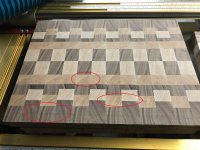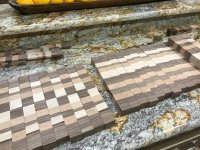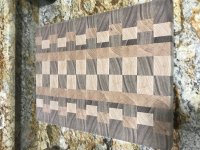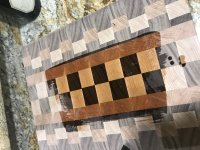Hi all,
I have a question regarding finish sanding. I made a batch of 5 end grain cutting boards and ran them through my drum sander with 120 grit sand paper. I didn't realize till the end and I examined the boards closely that my sander made fairly deep scratches in the wood (see red ovals in the picture) so I did the following to buff them out
Started with 40 (tried 80 first, but the scratches wouldn't come out), then 80, 120, 150 and finished with 220 grit on my RO90 and ETS150 (I don't have all grits for either sander so used both with what I had on hand). With 5 boards, this took a really long time.
So my questions are:
1. Do I need to run through all these different grits to get a good finish sanding? (I don't have 180 otherwise I probably would have added this in as well)
2. How much sanding with each successive grit is needed? Would, say 3 light passes on each grit work before moving to the next one? How do I know when I've sanded enough on each grit?
Pictures of the final sanded board and beginning mineral spirit coating also included.
Thanks for the input,
Bryan
I have a question regarding finish sanding. I made a batch of 5 end grain cutting boards and ran them through my drum sander with 120 grit sand paper. I didn't realize till the end and I examined the boards closely that my sander made fairly deep scratches in the wood (see red ovals in the picture) so I did the following to buff them out
Started with 40 (tried 80 first, but the scratches wouldn't come out), then 80, 120, 150 and finished with 220 grit on my RO90 and ETS150 (I don't have all grits for either sander so used both with what I had on hand). With 5 boards, this took a really long time.
So my questions are:
1. Do I need to run through all these different grits to get a good finish sanding? (I don't have 180 otherwise I probably would have added this in as well)
2. How much sanding with each successive grit is needed? Would, say 3 light passes on each grit work before moving to the next one? How do I know when I've sanded enough on each grit?
Pictures of the final sanded board and beginning mineral spirit coating also included.
Thanks for the input,
Bryan




